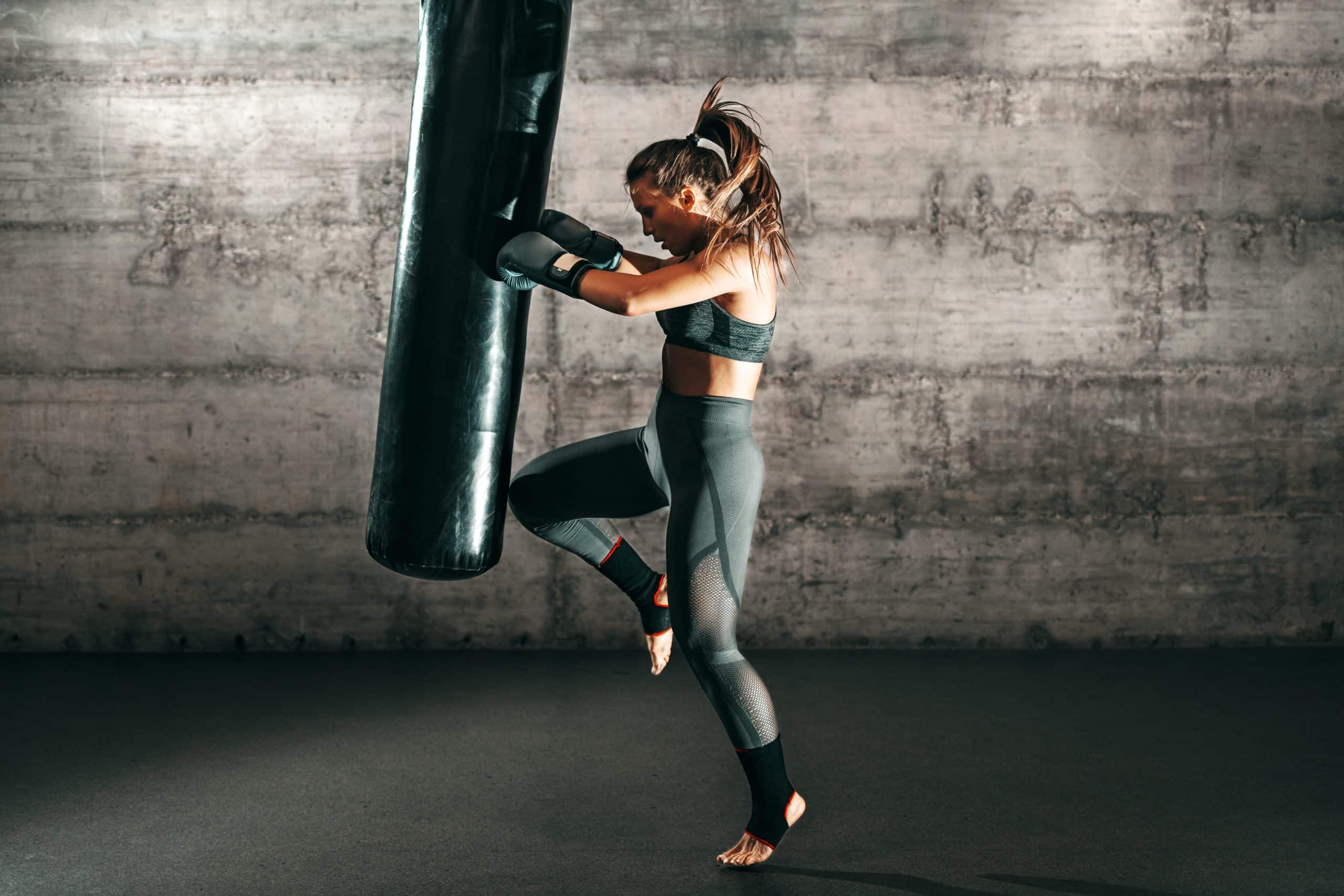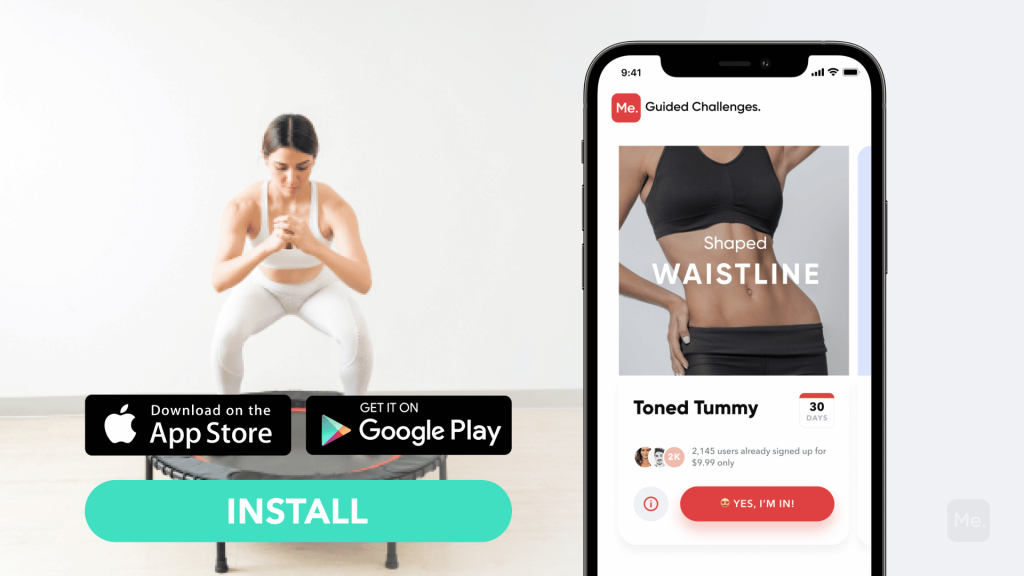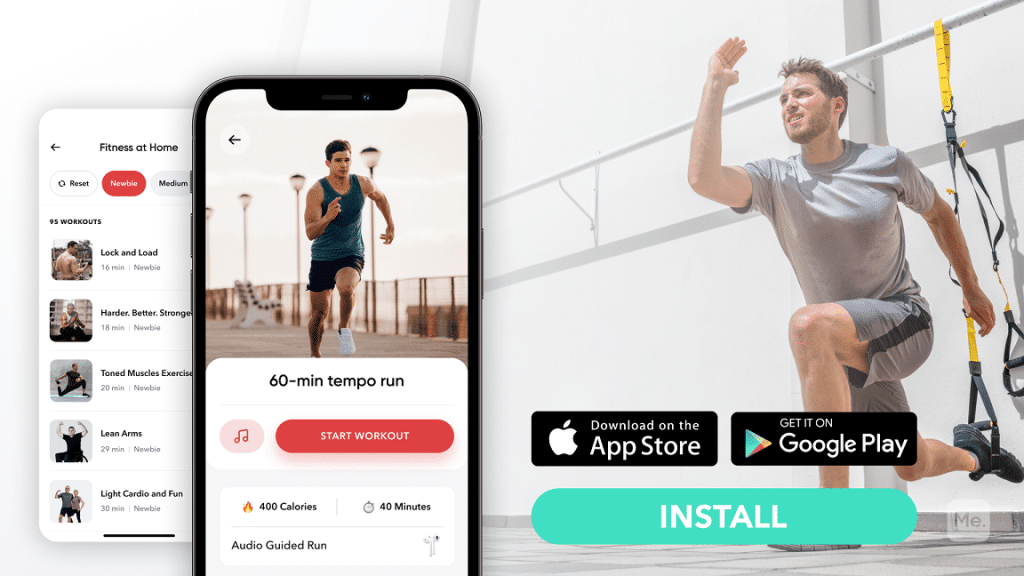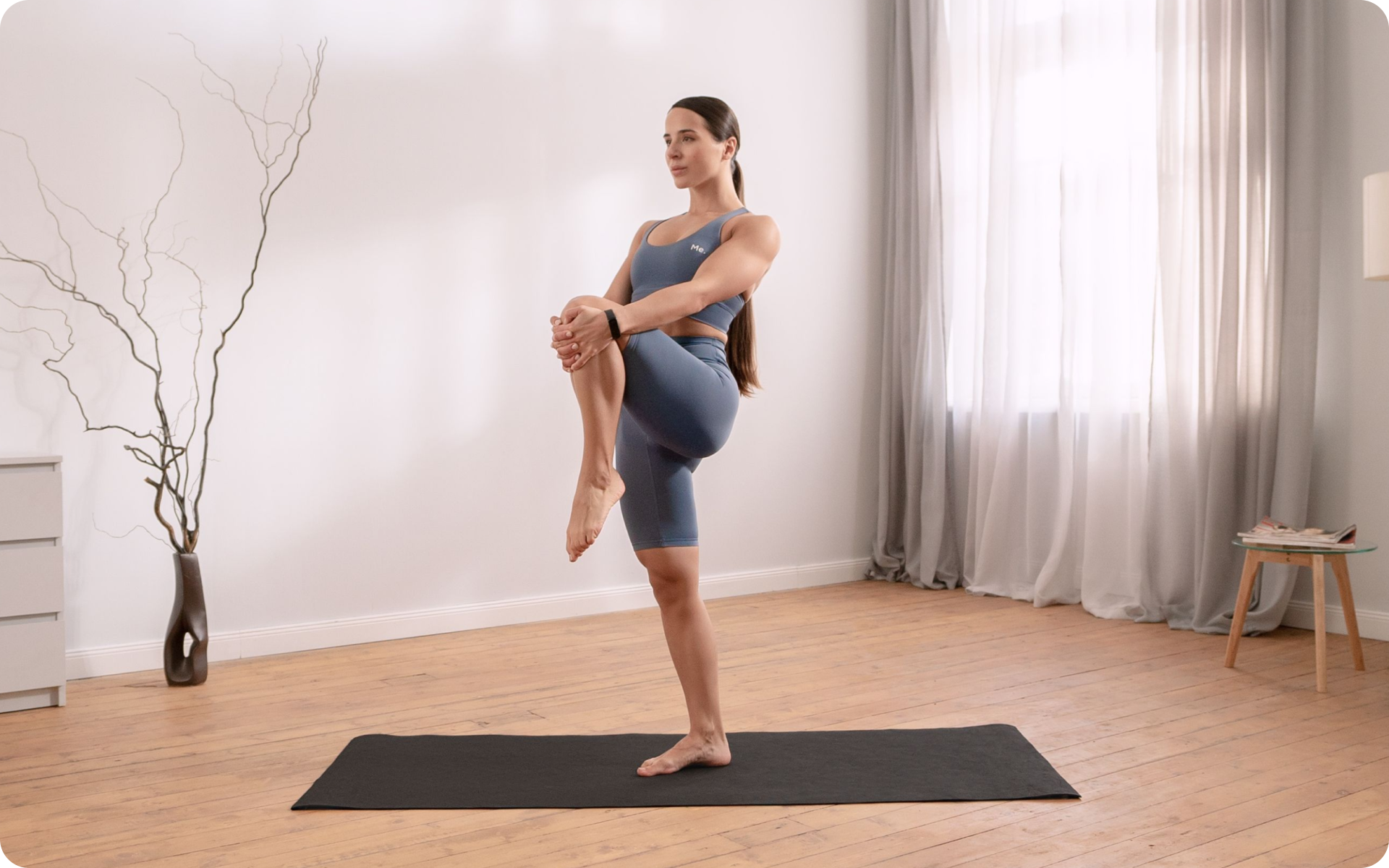Kickboxing is a brutal, high-octane sport. It is an off-shoot of Muay Thai, the national sport of Thailand. The name ‘kickboxing’ was first coined in Japan in the 1950s, when American Karate practitioners started to incorporate Muay Thai techniques into their own art (9). This stand-up combat sport uses punches and kicks; hence the name ‘kickboxing’. Opponents face each other in a ring, and the aim is to either knock out your opponent, or score enough points to win by decision. Boutique fitness studios across the globe are now offering cardio kickboxing classes, which are based on the same principles as the sport, but without the contact.
Unlike traditional Muay Thai or kickboxing training, which is more focused on developing technique and power, cardio kickboxing is designed to be a full-body workout that gets your heart rate up and burns calories. It’s less about learning how to fight, and more about getting a great workout.
Here’s everything you need to know about cardio kickboxing, including the benefits of this type of exercise, how to get started, and a sample beginner workout.
What Is Cardio Kickboxing?
Cardio kickboxing is a type of workout that combines elements of boxing, Muay Thai, and karate. It usually takes place in a group fitness class setting, with music playing to help keep participants motivated.
The class will typically involve punching and kicking combinations that are performed for set periods of time, followed by brief rest periods. The aim is to keep moving for the entire class, and to get your heart rate up so that you can burn calories and fat.
The basic movements in a cardio kickboxing class are relatively simple:
- Jab: A quick, straight punch with your lead hand.
- Cross: A powerful punch thrown with your rear hand.
- Hook: A punching movement where you rotate your body and arm to strike your opponent with the side of your fist.
- Uppercut: An upward punching movement, usually used when an opponent is bent over.
Cardio kickboxing classes usually last for around 45 minutes to an hour. They can be quite challenging, but they’re also a lot of fun.
Read More: Low Intensity Steady State Cardio: Yay Or Nay?
What Kind Of Exercise Does A Cardio Kickboxing Routine Provide?
Cardio kickboxing is an excellent form of aerobic exercise. An aerobic exercise is any type of activity that gets your heart rate up and makes you breathe more heavily.
When performed regularly, aerobic exercises can help to improve your cardiovascular fitness and reduce your risk of heart disease.
Aerobic exercises are often contrasted with anaerobic exercises, which is any type of activity that is performed at a high intensity for a short period of time. Examples of anaerobic exercises include sprinting and lifting weights.
How many calories you burn during a cardio kickboxing class will depend on your weight, intensity level, and how long the class lasts. However, the American Council on Exercise estimates that this high-energy workout can burn between 350 and 450 calories an hour (2).
Cardio kickboxing can also be a great form of resistance training. Resistance training is any type of exercise that helps to build muscle and bone mass. It can be performed using your own body weight, or with external weights such as dumbbells or barbells.
For it to have the muscle-building benefits, the resistance must be significant enough that it challenges your muscles. To make cardio kickboxing an effective form of resistance training, you can hold dumbbells while you punch and kick.
The Benefits Of Cardio Kickboxing
Cardio kickboxing provides all the benefits of aerobic exercise, plus some additional ones. Here are some of the main benefits of this type of workout:
1. Heart Health
Despite being one of the most important organs in the body, the heart doesn’t get much of a workout in our day-to-day lives. It’s also exposed to a lot of stress from things like unhealthy diets, smoking, and sedentary lifestyles.
Regular aerobic exercise helps to keep the heart muscle strong and healthy. It also reduces the risk of heart disease by lowering blood pressure and improving cholesterol levels (4).
When you’re deep into a 55-minute cardio kickboxing class, several processes are taking place that are good for your heart health, including:
- The arteries are dilating to allow more blood flow.
- The heart is pumping more blood with each beat.
- The left ventricle (the chamber of the heart responsible for pumping oxygenated blood to the body) is enlarging and getting stronger.
- The heart rate is increasing, which makes the heart work harder and get stronger.
If you tend to let yourself off the hook, raise the white flag when things get tougher than you expected, send yourself on an unconscious binge-eating trip – BetterMe app is here to help you leave all of these sabotaging habits in the past!
2. Weight Loss
Cardio kickboxing can be an effective weight-loss tool, especially when combined with a healthy diet. To lose weight, you need to create a calorie deficit, which means you need to burn more calories than you’re consuming (11).
Cardio exercises like kickboxing are a great way to burn calories. As we mentioned earlier, you can burn between 350 and 450 calories in just one hour of cardio kickboxing. Combine that with a healthy diet, and you’re well on your way to achieving your weight-loss goals.
3. Improved Coordination
Cardio kickboxing is a great workout for improving coordination (o). The punching and kicking movements require you to use both your arms and legs, which can help to improve the coordination between the two sides of your body.
This is a valuable skill to have, as good coordination can help you perform everyday activities more easily and reduce your risk of injury.
4. Improved Balance
Cardio kickboxing also helps to improve balance (16). The constant movement and changing of positions (from standing to squatting to kicking) challenge your sense of balance and help to improve your balance over time.
Improved balance is important for falls prevention, as well as overall joint health especially in older adults (12).
5. Stress Relief
There’s no doubt about it, cardio kickboxing is a great way to blow off some steam and relieve stress. The physical exertion can help to release built-up tension, and the punching and kicking movements can be cathartic.
In addition, the endorphins released during exercise can help to improve your mood and reduce stress levels (5).
6. Better Sleep
Poor sleep is linked to a number of health problems, including obesity, type 2 diabetes, and depression (8). Getting regular exercise can help to improve sleep quality (15).
Cardio kickboxing is a great workout for improving sleep quality. Physical activity can help to tire you out, and the endorphins released during exercise can help to improve your mood and reduce stress levels.
7. Improved Joint Health
Regular aerobic exercise like cardio kickboxing helps to improve joint health (3). It does this by:
- Increasing the production of synovial fluid, which lubricates the joints.
- Strengthening the muscles around the joints.
- Improving range of motion.
Healthy joints are important for overall mobility and quality of life.
Read More: Is Walking Cardio? Here’s What Experts Say
8. Increased Endurance
Endurance is the body’s ability to sustain physical activity for an extended period of time (6). Kickboxing is a great workout for increasing endurance because it challenges both your aerobic and anaerobic energy systems.
The constant movement in kickboxing elevates your heart rate and challenges your cardiovascular system. The bursts of speed and power also challenge your anaerobic energy system.
Improving your endurance can help you to better meet the demands of daily life and physical activity.
9. Self-Defense Skills
While cardio kickboxing won’t turn you into a professional fighter, it can give you the basic skills and confidence you need to defend yourself in a dangerous situation.
The punching and kicking movements can help to build strength and power, while the defensive drills can teach you how to react if someone tries to attack you.
Your confidence will also improve, which can be helpful in a self-defense situation.
10. Improved Mental Health
Regular exercise has been shown to improve mental health. It can help to reduce stress and anxiety, and it can also improve mood and cognitive function (7).
Research into depression and anxiety has shown that exercise can be as effective as medication in some cases (14). There are notable changes in the brain which are caused by exercise and that can translate into improved mental health.
11. Fun Workout
Last but not least, cardio kickboxing is just plain fun! It’s a great workout for people who get bored easily, as it’s always changing and there’s never a dull moment.
Plus, the group atmosphere of most classes can help to motivate you and make the time fly by.
How To Get An Effective Cardio Kickboxing Workout
It might seem like all you have to do while performing your kickboxing workout at home is throw a few punches and kicks in the air, but there’s a little bit more to it than that. Here are some tips to help you get the most out of your cardio kickboxing workout:
1. Practice The Moves In Slow Motion
Like all other exercises, proper form is important in kickboxing. Before you start throwing punches and kicks at full speed, take some time to practice the moves in slow motion.
This will help you to get a feel for the correct form and ensure that you’re using the right muscles. It’s also a good way to prevent injuries. Below are some tips for proper form while performing common kickboxing moves:
- Stay on the balls of your feet: you’ll be on your feet for the majority of the workout. The balls of your feet provide more stability and allow for better balance.
- Brace your core: a strong core is important for both stability and balance. Be sure to engage your core muscles throughout the workout. This will also help create force and resistance while you’re punching and kicking.
- Don’t extend your limbs fully during a movement: when you’re throwing a punch or kick, stop just before your arm or leg is fully extended. This will help keep your joints soft, prevent hyperextension and injuries.
Footwork is another important part of kickboxing. It helps you to stay balanced and provides the foundation for all of your punches and kicks. There are two main types of footwork used in kickboxing:
- Shuffle: this is a quick, side-to-side movement that helps you to stay light on your feet. It’s often used to create distance between you and your opponent.
- Stance: there are three main stances used in kickboxing: orthodox (right-handed), southpaw (left-handed), and switch. Each stance has its own advantages and disadvantages, so it’s important to learn all three.
- Orthodox: this is the most common stance used in kickboxing. It provides more power for your right hand, which may be your dominant hand.
- Southpaw: this stance is the opposite of orthodox. It provides more power for your left hand, which may be your non-dominant hand.
- Switch: this stance is used when you need to quickly change directions or when you want to confuse your opponent.
Other stances such as the horse stance, cat stance, and crane stance are also used in kickboxing, but these are the three most common.
Intense sweat sessions, working weight loss tips, lip-smacking recipes come in one package with the BetterMe app. And all of it is at your fingertips, start transforming your life now!
2. Have A Pre And Post-Workout Routine
What you do before and after your workout is just as important as the workout itself. Be sure to warm up before you start kicking and punching to get your muscles loose and to prevent injuries.
A simple 5-10 minute warm-up of light cardio and dynamic stretching is all you need. After your workout, it’s important to cool down and stretch again. This will help your muscles to recover and prevent soreness.
3. Use Proper Equipment
While you don’t need much equipment to do a kickboxing workout at home, there are a few things that can help to make it more effective. Investing in a quality pair of gloves, hand wraps, and a punching bag is worth the money.
- Gloves: using gloves will help to protect your hands and wrists while you’re punching. It’s important to choose a pair of gloves that fit snugly and are comfortable to wear.
- Hand wraps: hand wraps provide support for your wrist and knuckles. They also help to absorb the impact of your punches.
- Punching bag: a punching bag is a great way to increase the intensity of your workout. It also provides an opportunity to practice your punches and kicks.
4. Fuel And Hydrate Properly
Cardio kickboxing will help you to burn a lot of calories, so it’s important to fuel your body properly before and after your workout. A pre-workout snack should be high in carbs and low in fat to give you energy (13).
Post-workout, you’ll want to replenish your glycogen stores with a carb-rich meal or snack. Be sure to stay hydrated throughout the day, especially on days that you’re working out. Drinking plenty of water will help your body to recover and prevent muscle soreness (10).
Sample Cardio Kickboxing Workout For Beginners
Here is a sample cardio kickboxing workout for beginners, adapted from the Athletics and Fitness Association of America (1). It includes a warm-up, main workout, and cool-down. Some acronyms are used in the main workout section. They stand for:
- RHFS – Right-Hand Fighting Stance
- LHFS – Left-Hand Fighting Stance
- HS – Horse Stance
Warm Up
RHFS:
- Jab x 8
- Cross x 8
- Jab/Cross (½ tempo) x 8
- Hook x 8
- Uppercut x 8
- Hook/Uppercut x 8
- Jumping Jacks (transition to LHFS and repeat)
- Knee strike/March three x 8
- Front Kick (low)/March three x 8
- DBL Step touch/sidekick (alternating sides) x 8
- Back kick/March three x 8
Main Workout
Block A
HS:
- 4 Jabs R moving R/4 Jabs L moving L x 8
- 4 Jabs R/L/R/L (tempo)/2 Uppercut (slow) x 8
- Hook (slow) x 8
- 8 Alt Jabs (tempo)/4 uppercut (tempo)/2 hooks (slow) X 8
Block B (8ct combo)
RHFS:
- Jab/Cross/Hook (4) Boxer’s shuffle (4) X 4
- Change Boxer’s shuffle to front knee/back knee X 4
- Change back knee to back kick x 8
- Jump rope (transition to LLFS)
Block C (16ct combo)
LHFS:
- Hook R/L (4) Boxer’s shuffle (4) x 4
- Change Boxer’s shuffle to step L, right knee
- Change Knee to front kick
- Jumping Jacks (transition to LLFS)
Cool Down
- Static stretching for all major muscle groups
- Foam rolling (optional)
The Bottom Line
Cardio kickboxing is a great way to get a full-body workout. It’s also an effective way to burn calories and improve your cardiovascular health. If you’re new to kickboxing, be sure to start with a beginner-level workout and gradually increase the intensity as you get more comfortable.
Always warm up and cool down before and after your workout, and be sure to stay hydrated throughout the day.
Get your personalized
meal plan!
DISCLAIMER:
This article is intended for general informational purposes only and does not serve to address individual circumstances. It is not a substitute for professional advice or help and should not be relied on for making any kind of decision-making. Any action taken as a direct or indirect result of the information in this article is entirely at your own risk and is your sole responsibility.
BetterMe, its content staff, and its medical advisors accept no responsibility for inaccuracies, errors, misstatements, inconsistencies, or omissions and specifically disclaim any liability, loss or risk, personal, professional or otherwise, which may be incurred as a consequence, directly or indirectly, of the use and/or application of any content.
You should always seek the advice of your physician or other qualified health provider with any questions you may have regarding a medical condition or your specific situation. Never disregard professional medical advice or delay seeking it because of BetterMe content. If you suspect or think you may have a medical emergency, call your doctor.
SOURCES:
- A Breakdown of Cardio Kickboxing (n.d., blog.afaa.com)
- ACE Helps Exercisers Kick Their Way to Fitness with Cardio Kickboxing (1999, acefitness.org)
- Aerobic Activity in Prevention & Symptom Control of Osteoarthritis (2014, ncbi.nlm.nih.gov)
- Effects of aerobic exercise on the blood pressure, oxidative stress and eNOS gene polymorphism in pre-hypertensive older people (2010, pubmed.ncbi.nlm.nih.gov)
- Effects of Exercise and Physical Activity on Anxiety (2013, frontiersin.org)
- Endurance Exercise – Physiopedia (n.d., physio-pedia.com)
- Exercise for Mental Health (2006, ncbi.nlm.nih.gov)
- Extent and Health Consequences of Chronic Sleep Loss and Sleep Disorders – Sleep Disorders and Sleep Deprivation (2006, ncbi.nlm.nih.gov)
- Kickboxing History – WKN (n.d., worldkickboxingnetwork.com)
- Nutrient Timing: What to Eat Before and After a Workout (n.d., blog.nasm.org)
- Optimal Diet Strategies for Weight Loss and Weight Loss Maintenance (2020, ncbi.nlm.nih.gov)
- Physical activity programs for balance and fall prevention in elderly (2019, ncbi.nlm.nih.gov)
- Pre-Exercise Nutrition: The Role of Macronutrients, Modified Starches and Supplements on Metabolism and Endurance Performance (2014, mdpi.com)
- The Benefits of Exercise for the Clinically Depressed (2004, ncbi.nlm.nih.gov)
- The bidirectional relationship between exercise and sleep: Implications for exercise adherence and sleep improvement (2014, ncbi.nlm.nih.gov)
- The effects of five weeks of kickboxing training on physical fitness (2014, ncbi.nlm.nih.gov)












